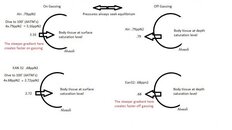At a given depth on nitrox the ppN2 is lower. Agreed? Thus when any given tissue becomes saturated, ie the tissue ppN2 reaches the inspired ppN2, there will be less nitrogen in the tissues. This is just the same as being at a lesser depth but on air. Staying longer on Nitrox you never catch up with being on air as the ambient ppN2 is lower. Saturated on nitrox is not the same as saturated on air.
One of the limiting factors in ascent speed is DCS. Decompression algorithms try to limit the rate at which gas comes out of solution and forms bubbles, with less gas in solution to begin with there is less chance of forming bubbles. Just as running for the surface immediately is not as dangerous as running for the surface at the end of a dive. There is just less nitrogen to cause a problem.
I am not saying fast ascents are safe, just less dangerous on richer mixes.
For other claims of wellbeing and lack of narcs I don't see that myself. I dive it because it lets me stay longer for shorter stops and be on average safer while I am there.





